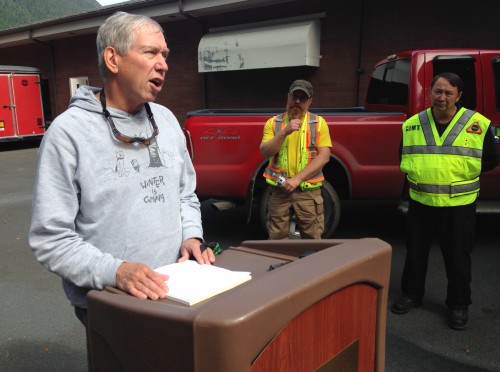One year ago, on August 18, 2015, massive rainfall generated over 40 landslides on Baranof and Chichagof Islands. And in Sitka, one of those landslides swept through a subdivision under construction. The slide occurred at 9:41 in the morning, demolishing one home and taking the lives of two painters, Elmer and Ulises Diaz, working inside. A third individual, William Stortz, was Sitka’s building official. He was inspecting drainage outside nearby when the slide caught him too.

Joel Curtis is a National Weather Service meteorologist who was in Sitka last August to train Coast Guard pilots. Following the slide, he became the incident meteorologist for the duration of the recovery effort. In part 1 of a 5-part series looking back on the Sitka landslide, Curtis talks with KCAW’s Robert Woolsey about returning to the scene of “one of the major events” of his professional life a year later.
Curtis – So I had my shoes and my raincoat, and I said What the heck? I’ll hike up there a bit. And I was stunned at how the stratigraphy of the debris has changed since the initial slide. How much the debris has settled. I’ll just give you an example: I remember there was a gravel berm at the base of the slide on Kramer Avenue. And I could look out into the debris at these flat areas where you could see mud. This was just after the slide, when we’re still very worried that it would still move. And I remember taking a rock and throwing it out there and it would go p-l-o-p. A big ole plop, and mud would fly as you did that. And yesterday I saw one little place in the stream where there was debris like that, and I thought, Well I’ll make a test, and I threw the same-sized rock out on the thing and it went t-h-u-d. That stuff has really, really settled, and so have all the small rocks and cobbles and boulders, and they’re now embedded in that stuff. I felt perfectly safe hiking on that. Now I don’t know if that’s really safe, and somebody might tell me ‘No, no Joel, you’re wrong.’ Maybe that’s an unsafe area. But even with the rain that we’ve just had I felt very safe walking on it.
KCAW – It wasn’t just my imagination, but after the August 18 rainfall and landslide events, the National Weather Service did start dropping in more advisories about mudslides. Didn’t that increase slightly?
Curtis – (sighs) Yeah, it did. I tell you it was on our minds for a couple of reasons: Number one, we had saturated soils here. And any time that you get super-saturated soils it’s got to be in the back of your mind. And of course, we had that tragic, tragic event happen here, so we were probably a little bit snakebit. That just happens in human psychology. The guys are looking at it harder and going, ‘Gosh, I sure don’t want to miss that,’ and so they err on the side of caution and they started mentioning it (in the forecasts). I think about a month afterward we all had a collective feeling, ‘Hey that’s not really a good call that we can make.’ And we adjusted ourselves. We’ve mentioned that just a few too many times, and we’ll get out of that business and save it as sort of the silver bullet. In other words, ‘Gosh we really have the super-saturated soil and we really have a huge amount of rain coming, and we really have some strong winds with a wind shift.’ Those are really the only thing that the weather service can add to the puzzle of landslides and mudslides.
Joel Curtis is the Warning Coordination Meteorologist with the National Weather Service in Juneau. He served as the incident meteorologist in the aftermath of the August 18, 2015 landslide in Sitka.
Over the next four days we’ll hear from others who played significant roles in Sitka’s effort to manage — and recover from — the slide.
Robert Woolsey is the news director at KCAW in Sitka.




